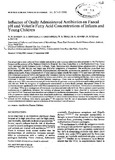Mostrar el registro sencillo del ítem
Influence of Orally Administered Antibiotics on Faecal pH and Volatile Fatty Acid Concentrations on Infants and Young Children
| dc.creator | Marsh, W. W. | |
| dc.creator | Hentges, D. J. | |
| dc.creator | Chavarría Milanés, José Fernando | |
| dc.creator | Thal, W. R. | |
| dc.creator | Adams, M. K. | |
| dc.creator | Achí Araya, María Rosario | |
| dc.creator | Mata Jiménez, Leonardo | |
| dc.date.accessioned | 2015-08-07T16:31:35Z | |
| dc.date.available | 2015-08-07T16:31:35Z | |
| dc.date.issued | 1990 | |
| dc.identifier.citation | http://www.microbecolhealthdis.net/index.php/mehd/article/view/7491/8835 | |
| dc.identifier.issn | 1651-2235 | |
| dc.identifier.issn | 0891-060X | |
| dc.identifier.uri | https://hdl.handle.net/10669/15180 | |
| dc.description | Artículo científico -- Universidad de Costa Rica, Instituto de Investigaciones en Salud. 1990 | es_ES |
| dc.description.abstract | Faecal specimens were collected from infants and children with common infections who presented to the Paediatrics Outpatient Department of the National Children's Hospital, San Jose, Costa Rica or to the Paediatrics Clinic, Texas Tech University Health Sciences Center, Lubbock, Texas. Specimens were obtained before administration of various antibiotics, 7 d after therapy was begun and 28 d after completion of treatment. The antibiotics prescribed were either amoxicillin, ampicillirt, cephalexin, choramphenicol, dicloxocillin, erythromycin, penicillin or trimethroprim/ sulphamethoxazole. Faecal concentrations of total and individual volatile fatty acids (VFA) and faecal pH levels were determined and compared before, during and after treatment with the various antibiotics. Specimens, collected during the same time periods from a group of healthy infants and children who were not taking antibiotics, were evaluated to determine if normal fluctuations occurred between samplings. There were no significant differences in the Texas subjects in total VFA concentrations and pH levels between the patients receiving antibiotics and healthy participants who did not. With the exception of erythromycin administered to Costa Rican patients, therapeutic doses of the antibiotics did not significantly alter total VFA concentrations or pH levels of the faeces. Variations in concentrations of individual VFAs as a consequence of treatment were demonstrated only in Costa Rican patients teceiving either erythromycin or cephalexin; however, the patterns of change were similar to those observed in untreated control participants from Texas and were therefore not attibuted to antibiotic administration. These results are in accordance with our previous studies which show that absorbable antibiotics, administered to mice in therapeutic doses, do not significantly alter total VFA concentrations or pH levels of caecal contents and do not increase the susceptibility of the animals to oral challenge with enteric pathogens.' We speculate that the use of absorbable antibiotics does not compromise natural resistance against infections of the intestinal tract of humans. | es_ES |
| dc.description.sponsorship | Texas Tech University Health Sciences Center | es_ES |
| dc.description.sponsorship | Hospital Nacional de Niños, Costa Rica. | es_ES |
| dc.description.sponsorship | Universidad de Costa Rica, Instituto de Investigaciones en Salud | es_ES |
| dc.language.iso | en_US | es_ES |
| dc.source | Microbial Ecology in Health and Disease 3(1): 7-13 | es_ES |
| dc.subject | Costa Rica | es_ES |
| dc.subject | antibiotics | es_ES |
| dc.subject | faecal pH | es_ES |
| dc.subject | volatile fatty acid concentrations | es_ES |
| dc.subject | infants | es_ES |
| dc.subject | young children | es_ES |
| dc.subject | volatile fatty acids (VFA) | es_ES |
| dc.subject | Salud pública | es_ES |
| dc.subject | Child development | es_ES |
| dc.title | Influence of Orally Administered Antibiotics on Faecal pH and Volatile Fatty Acid Concentrations on Infants and Young Children | es_ES |
| dc.type | artículo original | |
| dc.description.procedence | UCR::Vicerrectoría de Investigación::Unidades de Investigación::Ciencias de la Salud::Instituto de Investigaciones en Salud (INISA) | es_ES |


